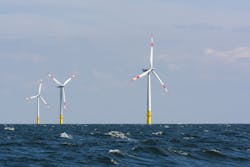Siemens Wins 2 GW Offshore Wind Transmission Connection Deal in Germany
German transmission system operator Amprion awarded a contract for two converter systems by Siemens Energy and Dragados Offshore. This power grid connection will transport up to 2 GW of offshore wind power to the German power grid.
In total, up to four gigawatts of green electricity from several offshore wind farms in the German North Sea can be transported to shore. The contract is worth more than €4 billion, including a decade of maintenance. For Siemens Energy it is the largest offshore grid connection order the company has received to date.
With the Wind Energy at Sea Act, the German government set the framework for further expansion of offshore wind energy in Germany: Installed capacity is to increase to at least 30 GW by 2030 and as much as 70 GW by 2045. However, this requires more than just new wind farms. More powerful high-voltage direct-current (HVDC) transmission systems must be built to transport electricity over long distances.
The increase in transmission capacity to 2 GW represents a technological leap, as more wind farms can now be connected to the grid via the new systems. Siemens Energy's recently implemented projects had a transmission capacity of 900 MW. Siemens Energy used a "bipolar configuration" design to create the two-gigawatts systems, meaning they can effectively operate at twice the voltage and transmit twice the power.
Siemens Energy's scope of supply consists of two converter platforms at sea and two associated stations on land. The wind turbines generate alternating current and feed it into the converter platforms, which convert the alternating current into direct current. Only in this way can large amounts of energy travel the long distance of around 390 kilometers (242 miles) each to the two converter stations on land via a direct current cable. The converter stations on land are being built near Wehrendorf in Lower Saxony and Westerkappeln in northern North Rhine-Westphalia.
Siemens Energy will manufacture all major high-voltage equipment for the two connection systems, such as converter technology, transformers, and switchgear, in Germany and will assume the systems’ complete maintenance for a period of 10 years. This includes services to ensure cyber security and transport logistics, such as the provision of service ships and helicopters. The Spanish consortium partner, Dragados Offshore, is responsible for the construction and offshore installation of the associated platforms. Construction will take place at the company's shipyard in Cadiz, Spain.
In addition, the systems are designed to be integrated into multi-terminal-systems in the future. Instead of pure point-to-point connections, several direct current connections could converge in one station. These direct-current grids on land and on the high seas (as offshore hubs) are intended to bring electricity to consumers more flexibly and quickly. The converter systems will then act as electricity hubs at the grid nodes that transmit the electricity according to the demand situation.
The connection systems are expected to transmit power as early as 2029 and 2030, supporting Germany's accelerated energy transition goals.
About the Author
T&D World Staff
Content Team
Nikki Chandler
Group Editorial Director, Energy
[email protected]
Jeff Postelwait
Managing Editor
[email protected]
Christina Marsh
Senior Editor
[email protected]
Ryan Baker
Associate Editor
[email protected]
Amy Fischbach
Electric Utility Operations
[email protected]
Rich Maxwell
Community Editor
[email protected]
Gene Wolf
Technical Editor
[email protected]
